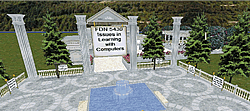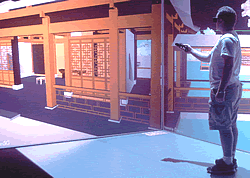2006 Campus Technology Innovators: Virtual and Immersive Learning

TECHNOLOGY AREA:
VIRTUAL AND IMMERSIVE LEARNING
Innovators: Appalachian State University
& Purdue University
Innovator: Appalachian State University

APPALACHIAN STATE UNIVERSITY’S AET ZONE:
A 3D, IMMERSIVE, SCALABLE WORLD
Challenge Met
The Instructional Technology graduate degree
program at Appalachian State University
(NC) serves hundreds of students each year,
almost all of whom live and work more than
30 miles from campus. The typical student is
a mid-career educator who is not familiar
with immersive learning environments, has
only a basic understanding of traditional
web-based learning systems, and has access
to rather modest technology.
Online instruction may have been an
obvious choice to serve these geographically
dispersed students, but ASU had specific
objectives to meet before it would call
the program a success. The stated challenge
was to “create an online learning
environment that: maintains fidelity to our
conceptual framework; supports our social
constructivist teaching methods; allows for
serendipitous, non-structured interactions
between students, instructors, and others;
and supports participants’ sense of presence/
absence of others.” Their solution is
AET Zone, a 3D, immersive world for learning
that serves as the social, curricular, and
pedagogical hub for all content and most
interactions in the Instructional Technology
program.
Nearly 900 “citizens” log on to AET Zone
to attend classes, meet with peers or
instructors, give or attend presentations, or
even just hang out. Students head to AET
Zone from different geographic locations
and classes, multiple sections of the same
classes, and multiple program areas. And
students’ Zone citizenships are not revoked
once the course in which they have enrolled
is over. Instead, current and former students
mix with instructors and visitors from
around the world to create a truly vibrant
global learning community.
How They Did It
Members of the Instructional Technology
faculty at ASU’s Department of Leadership
and Educational Studies, (including John
Tashner, Stephen Bronack, and Dick Riedl)
have driven the AET Zone project from its
inception in 2001. They combined a suite of
tools to create AET Zone, selecting Activeworlds as a 3D
development platform because of affordability,
scalability, and the low bandwidth
requirements for use. They began with one
small world, but quickly moved to a multiworld
universe server, creating personalized
spaces for different groups of Zone citizens.
Still, additional resources were necessary to
make the environment most effective for
learning. Web-based discussion boards, voice-over-IP and
file sharing,
and a group-oriented custom course management
system built in-house each contributed
to the communication and
interaction between and among students,
instructors, and visitors.
“We may have begun with the notion of
creating an online space that was analogous
to and ‘as good as’ the typical blended
program,” says Tashner, “but we have
come to realize that the kinds of interactions
that occur through a combination of
peer network facilitation, varied communication
tools, and an immersive online social
environment are richer and more satisfying
than those supported by the traditional
classroom or web-based models.”
Next Steps
Today, ASU has opened its world to the larger
world. Educators, researchers, adult students,
and young students from the US,
Mexico, Australia, and Finland are using AET Zone as a place to meet, teach, and
learn. They are planning activities and building
spaces of their own within the Zone. As
the population of these new “citizens”
grows, ASU hopes that AET Zone will serve
as a model for educational institutions
looking to create effective, immersive social
environments for learning.
Advice
ASU’s Instructional Technology faculty agree
that scalability was a key factor in developing
AET Zone: “Look for technologies that
offer a small footprint at first, but that are
scalable when you succeed. In our case,
Activeworlds’ public education server provided
a quick, cost-effective way to get
started and eased our transition to our own,
private virtual world server.”
Innovator: Purdue University

PURDUE UNIVERSITY’S ENVISION CENTER:
A NEW WAY TO INTERACT WITH DATA
Challenge Met
The Envision Center for Data Perceptualization
at Purdue
University (IN) was conceived by a group of
faculty who saw a need for a central facility on
campus that would support visualization and
data perceptualization in research and teaching.
Traditional text and 2D displays were
falling short as a means to represent data
and concepts, and technology offered new
ways to involve a variety of senses—visual,
auditory, touch, and more—to immerse
users in environments for exploration, interaction,
and discovery. The center gives its
users a chance to work with the technologies
that serve them best in interpreting
data and concepts.
How They Did It
With a grant from NSF to partially fund the
center, the first step was benchmarking the
best visualization facilities at other campuses,
taking into consideration budget
constraints and facility size. The technology
assessment for the project was led by Gary
Bertoline, the director of the center, and
Dwight McKay, the technical architect. Intel and IBM donated workstations
and high-resolution monitors, and
the visualization vendors Fakespace, Hewlett-Packard, and
Barco provided valuable
information and recommendations.
The
center now incorporates a wide range of
technologies:
- VR Theater. VR Theaters immerse users in
the environment they are viewing. The
users are not just passive observers in
the computer-generated world, but are
interacting with the various components
of the environment in real time. Envision’s
VR Theater is a Fakespace FLEX system
featuring three 10’ x 8’ panels for rear
projection of large-scale 3D images.
- Motion Capture. The Envision Center
houses an STT Motion Captor optical motion capture system
that is operated in collaboration with
the Department of Visual and Performing
Arts. This system is composed of six
infrared cameras on tripods and as many
as three linked computers.
- Tiled Wall. The tiled display wall at the
Envision Center is a 12’ x 7’ high-resolution
display made up of a grid of 12
smaller projection displays controlled by
several computers working together. A
13-node PC cluster with Nvidia GeForce FX 3000G graphics
cards provide the computation and rendering
for the tiles.
- Access Grid. The Envision Center places
a premium on collaborating with
researchers and student groups at various
locations around the world. Users of
the Envision Center at Purdue can work
through the Access Grid on projects that incorporate
both local and remote presentation and
interactive environments.
Beyond the infrastructure elements listed
above, the Envision Center also offers a variety
of other assets, such as high-resolution,
portable stereo displays that can be used in
classrooms to enhance instruction through
the use of stereo graphics, sensing and haptic
devices (which allow a user to interact
with a computer by receiving tactile feedback),
nano-manipulation haptic devices,
and other high-performance computing
resources. In one room, you’ll find IBM T221
ultra high-resolution 22-inch flat-panel
monitors capable of displaying 9.2 million
pixels. And equipment from several major
vendors like IBM, Dell, Sun
Microsystems, and SGI helped make up the fabric of computing
resources at Purdue used in projects at the
Envision Center.
Next Steps
The Envision Center’s next major steps are
to increase the level of funded projects,
work toward a self-sustaining model, and
engage faculty on campus more fully.
Advice
From the initial benchmarking effort, planners
learned what works and what d'esn’t
at other centers around the country. Among
the lessons learned: Make sure technical
staff are included in the budget; meet vendors
and establish partnerships; and supplement
the hardware budget with vendor
donations.